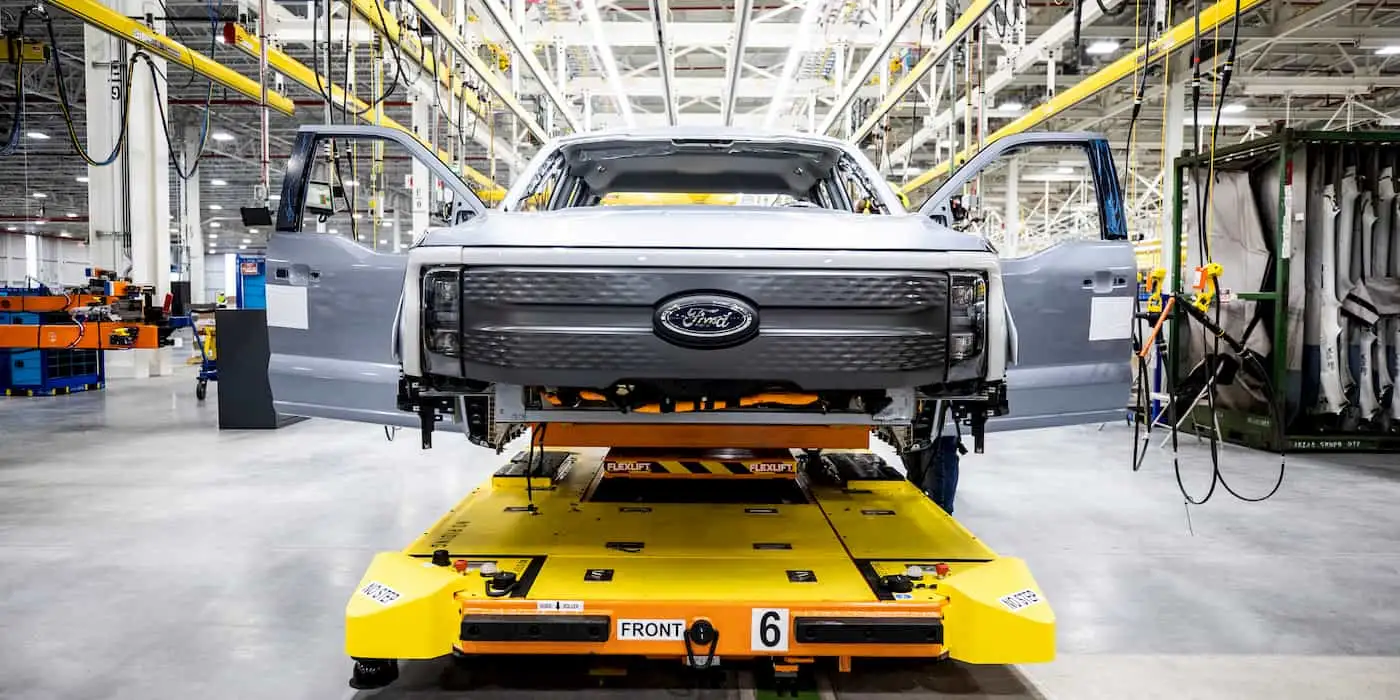Ford is pitching a sweeping reinvention of how it designs and builds electric vehicles—what CEO Jim Farley calls a new “Model T moment.” The centerpiece is a mid‑size electric pickup with a target starting price of about $30,000, scheduled to debut in 2027 from Ford’s upgraded Louisville operations in Kentucky. The truck rides on a freshly engineered Universal EV Platform and is assembled using a modular “assembly tree” process that breaks from the century‑old single conveyor line. Together, these moves aim to slash parts count and labor time, simplify the bill of materials, and enable profitable, mass‑market EVs at a time when affordability—and factory efficiency—matter more than ever.
Key facts at a glance
- First vehicle: a four‑door, mid‑size EV pickup with a target base price around $30,000, due in 2027.
- New platform: Universal EV Platform designed for pickups, SUVs, and more, with simplified electronics and software‑first architecture.
- Manufacturing: a three‑branch assembly tree that converges near the end, enabling fewer workstations and faster build times.
- Battery strategy: LFP prismatic cells (nickel‑ and cobalt‑free) used as a structural floor to cut cost and weight.
- Investment: multi‑billion‑dollar upgrades in Kentucky and a dedicated LFP battery facility in Michigan.
What makes the Universal EV Platform different
Ford’s Universal EV Platform is a clean‑sheet rethink built for cost and speed. The company says it reduces complexity at every layer, from body structure to wiring to software. Fewer unique parts and fasteners mean fewer stations to attend, less changeover, and fewer opportunities for defects. The electrical backbone is designed to be simpler and lighter, supporting over‑the‑air updates and a tighter integration between software features and hardware modules. Importantly, the platform is scalable: the same building blocks can underpin a pickup, a compact crossover, or a delivery van—with shared subassemblies that streamline procurement and logistics.
In practical terms, platform commonality protects margin. Instead of engineering each EV from scratch, Ford reuses expensive components, tooling, and validation work. This is the playbook that made legacy ICE platforms so profitable. Translating it to EVs—where battery cost and factory time dominate the profit equation—can be the difference between a product that sells at cost and one that generates cash.
The ‘assembly tree’: splitting—and shortening—the line
The signature manufacturing change is what Ford calls an assembly tree. Rather than pushing a single vehicle down one long line, Ford builds three major “limbs” in parallel—front, rear, and the central structural battery unit—then brings them together late in the process. By decoupling the biggest sub‑systems, Ford can run specialized stations with fewer tools and operators, reduce takt time, and compress the overall factory footprint. Early demonstrations highlight fewer parts and fewer fasteners versus typical designs, and Ford has referenced double‑digit improvements in assembly speed and reductions in workstation count.
There’s an ergonomic upside, too. Building sub‑assemblies separately allows more work to be done at optimal heights and orientations, reducing strain and error. That typically translates to better first‑time quality and fewer rework loops—an under‑appreciated lever in EV profitability where margin is razor‑thin.
Structural LFP batteries: cost, durability, and packaging
To hit the $30,000 target, Ford is leaning on lithium iron phosphate (LFP) cells. LFP chemistry is inherently nickel‑ and cobalt‑free, which lowers exposure to volatile commodity prices and eases supply‑chain risk. The prismatic LFP pack doubles as a structural floor, letting Ford remove redundant cross‑members and mount points while lowering the center of gravity. That frees cabin space (particularly for rear passengers), makes room for both a frunk and a traditional bed, and cuts mass without resorting to exotic materials.
While LFP can’t match nickel‑manganese chemistries on sheer energy density, the trade‑off often favors mainstream trucks and crossovers: long cycle life, robust thermal behavior, and lower cost per kWh. Combined with a more compact pack and simplified thermal management, Ford argues it can meet the daily range and towing needs of mid‑size pickup customers while keeping the entry price—and the five‑year cost of ownership—competitive with used ICE alternatives.
What to expect from the $30,000 mid‑size EV pickup
Ford is positioning the truck with interior room on par with popular mid‑size crossovers, aiming to maximize daily versatility rather than headline towing numbers. Expect a four‑door cabin, a usable frunk for tools and groceries, and a bed sized for weekend projects. Early guidance points to brisk everyday performance comparable to a modern turbocharged sport coupe, with targeted 0–60 mph times in the mid‑4‑second range on higher‑output variants. A 400‑volt architecture with bi‑directional power (vehicle‑to‑load and potentially home backup capability) has been highlighted, alongside connected features, driver‑assist options like hands‑free highway driving, and frequent OTA updates.
Crucially, the promise isn’t just about a single truck. The Universal EV Platform is built to spawn a family of affordable EVs—compact SUVs, work vans, perhaps even a next‑gen performance crossover—sharing battery and electronics strategies that lower per‑unit cost as volume scales. The pickup is simply the tip of the spear.
Factories, jobs, and the U.S. supply chain
Ford plans to spend billions retooling its U.S. footprint to build these vehicles profitably. The Louisville Assembly Plant is being overhauled to launch the pickup on the new platform in 2027, with Ford signaling meaningful reductions in station count and assembly time thanks to the modular workflow. In parallel, a Michigan battery facility is earmarked to produce LFP cells at scale, tightening the loop between cell manufacturing and vehicle assembly. Ford says these investments secure thousands of jobs across both states, even as the new process requires fewer touch‑labor hours per vehicle.
The macro logic is straightforward: building more of the high‑value battery content domestically reduces logistics costs and mitigates tariff and policy risk. It also positions Ford to iterate faster—important when pack design, thermal strategies, and software are evolving every model year.
Why Ford calls this a ‘Model T moment’
The Model T reference isn’t about nostalgia; it’s about process. A century ago, Ford’s moving line unlocked mass affordability by standardizing parts and tasks. Today’s EV reboot applies the same principle: standardization and modularity across batteries, castings, and electronics—plus a factory layout that serves the product, not the other way around. If the assembly tree and structural LFP approach deliver as promised, Ford could widen the price umbrella for EVs just as the market needs it.
The timing is delicate. Demand for premium‑priced EVs has cooled, incentives are in flux, and competition from both legacy players and China’s value leaders is intensifying. Ford’s EV unit has posted steep losses in recent periods, and management has been candid that profitable electrics require more than marketing—they need fewer parts, fewer hours, and lower battery costs. That’s precisely what this strategy targets.
Competitive context: Tesla, BYD, and the cost curve
Tesla’s efficiency advantage has long flowed from product‑process integration—large castings, simplified wiring, and relentless iteration. BYD attacks cost from a different angle: vertical integration into batteries and power electronics, plus massive domestic scale. Ford’s answer blends both: structural LFP packs aligned with casting‑friendly body engineering, software‑defined electronics to simplify harnesses and control units, and a parallelized assembly model that can ramp multiple sub‑systems at once. If it works, the $30,000 pickup can be more than a halo—it can be a volume engine that drags supplier pricing and utilization in the right direction for the rest of Ford’s EV lineup.
Risks and open questions
No manufacturing plan survives first contact without surprises. Key uncertainties include pack cost per kWh at launch volumes, the learning‑curve pace on the assembly tree, and how much capability Ford bakes into the base model to protect the $30,000 headline. Charging speed and winter range will face scrutiny in northern markets, and the real‑world economics of LFP in trucks—where payload and towing vary widely—will be tested by contractors and weekend warriors alike. Still, by concentrating on attainable pricing and total cost of ownership, Ford is aiming at the broadest part of the bell curve rather than the bleeding edge.
Bottom line: can a $30,000 EV pickup change the market?
If Ford can reliably build and sell a mid‑size EV pickup at $30,000 with mainstream range and performance, it changes the reference point for what an electric vehicle can cost in North America. For buyers, that means a credible alternative to a mid‑mileage used truck or crossover—without giving up utility. For Ford, it means moving the EV business from a loss leader to a scalable, cash‑generating segment. That’s why this is framed as a Model T moment: it’s not about a single model; it’s about a repeatable system that makes EVs make sense on the showroom floor and on the P&L.
Spec & feature highlights (what we know so far)
- Vehicle type: Mid‑size four‑door EV pickup
- Target base price: ≈ $30,000
- Planned launch: 2027 (Louisville, KY)
- Platform: Universal EV Platform (scalable)
- Battery: LFP prismatic cells used as a structural floor
- Manufacturing: Three‑branch “assembly tree” process
- Architecture: 400‑V, OTA updates, bi‑directional power
- Performance target: brisk acceleration; mid‑4‑second 0–60 mph on uprated trims (guidance)
SEO note: This article targets the keyword Ford Model T moment EV pickup. Use the same phrase in the post title, URL slug, meta description, and image alt text for best results.
Sources
Selected reporting and official materials referenced in this analysis:
- The Verge — Ford reveals breakthrough process for lower priced EVs (Aug 11–12, 2025)
- AP News — Ford hits the pedal on EV production with $2B overhaul of Kentucky plant (Aug 2025)
- Autoweek — Ford EV Pickup Is Coming in 2027, Priced at $30,000 (Aug 2025)
- InsideEVs — Ford’s Universal EV Production System Reinvents the Assembly Line (Aug 2025)
- Ford (official) — Affordable EV Platform and midsize electric truck overview (Aug 2025)
- CBS News — Ford says it’s investing $5B in EV production; $30,000 midsize truck (Aug 2025)



